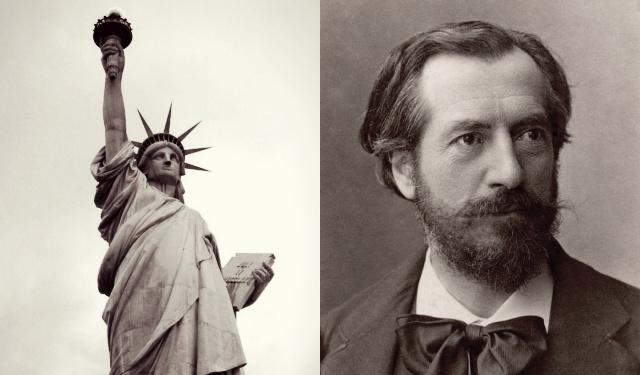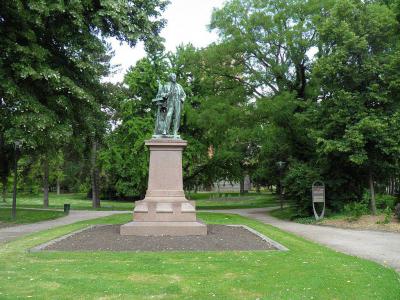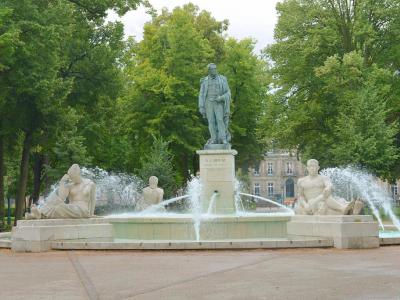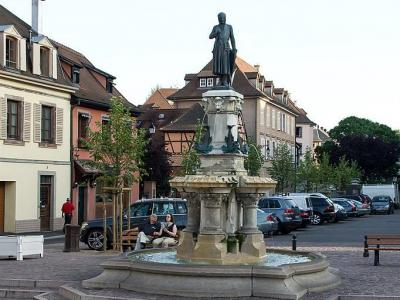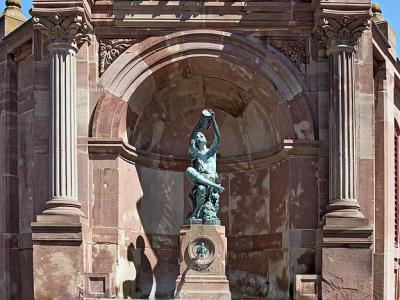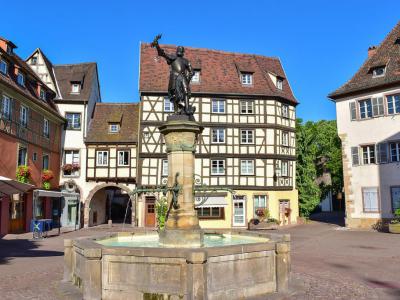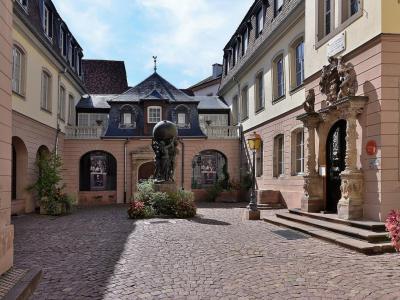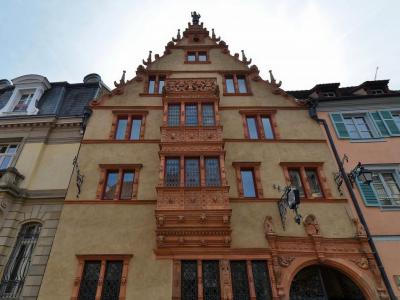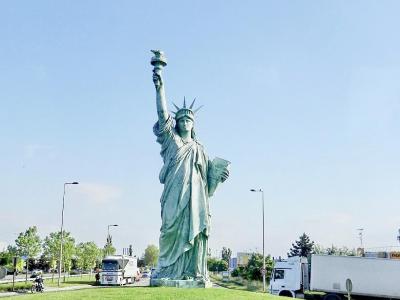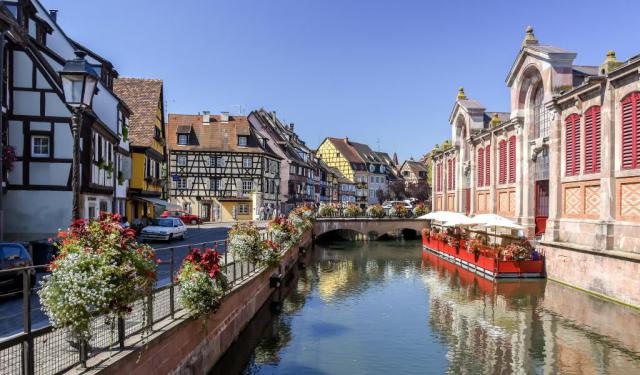Bartholdi's Statues in Colmar (Self Guided), Colmar
Auguste Bartholdi is one of the most famous artists from Colmar. His works, such as the Lion of Belfort in Belfort, France, and the Statue of Liberty in New York Harbor, are known around the world. Colmar is decorated with open-air pieces sculpted by the artist.
Many of Bartholdi's statues are found in fountains that occupy spaces in city squares or on significant street corners. Some of the sculptures created by Bartholdi are Fontaine Bruat (Bruat Fountain), Fontaine Roesselmann (Roesselmann Fountain), Statue du Peti Vigneron (Statue of the Little Winemaker, Schwendi Fountain, and the statue atop the Maison des Tetes (House of Heads).
Along with the statues in the city, visitors can tour the Bartholdi house. This house now functions as a museum dedicated to Bartholdi. Patrons of the museum will see some rooms that have been refurbished to look as they did when Bartholdi lived there. They will also find casts, models, and sketches of many of the artist's most famous works.
A replica of the Statue of Liberty will greet visitors that enter the city from the north. The replica was placed to commemorate the centennial of the death of Bartholdi.
The open-air statues can be challenging to find without a map and a plan. Take this self-guided walking tour to see some of the most important works of art in Colmar crafted by Auguste Bartholdi.
Many of Bartholdi's statues are found in fountains that occupy spaces in city squares or on significant street corners. Some of the sculptures created by Bartholdi are Fontaine Bruat (Bruat Fountain), Fontaine Roesselmann (Roesselmann Fountain), Statue du Peti Vigneron (Statue of the Little Winemaker, Schwendi Fountain, and the statue atop the Maison des Tetes (House of Heads).
Along with the statues in the city, visitors can tour the Bartholdi house. This house now functions as a museum dedicated to Bartholdi. Patrons of the museum will see some rooms that have been refurbished to look as they did when Bartholdi lived there. They will also find casts, models, and sketches of many of the artist's most famous works.
A replica of the Statue of Liberty will greet visitors that enter the city from the north. The replica was placed to commemorate the centennial of the death of Bartholdi.
The open-air statues can be challenging to find without a map and a plan. Take this self-guided walking tour to see some of the most important works of art in Colmar crafted by Auguste Bartholdi.
How it works: Download the app "GPSmyCity: Walks in 1K+ Cities" from Apple App Store or Google Play Store to your mobile phone or tablet. The app turns your mobile device into a personal tour guide and its built-in GPS navigation functions guide you from one tour stop to next. The app works offline, so no data plan is needed when traveling abroad.
Bartholdi's Statues in Colmar Map
Guide Name: Bartholdi's Statues in Colmar
Guide Location: France » Colmar (See other walking tours in Colmar)
Guide Type: Self-guided Walking Tour (Sightseeing)
# of Attractions: 8
Tour Duration: 3 Hour(s)
Travel Distance: 5.9 Km or 3.7 Miles
Author: DanaOffice
Sight(s) Featured in This Guide:
Guide Location: France » Colmar (See other walking tours in Colmar)
Guide Type: Self-guided Walking Tour (Sightseeing)
# of Attractions: 8
Tour Duration: 3 Hour(s)
Travel Distance: 5.9 Km or 3.7 Miles
Author: DanaOffice
Sight(s) Featured in This Guide:
- Monument Bartholdi (Bartholdi Monument)
- Fontaine Bruat (Bruat Fountain)
- Fontaine Roesselmann (Roesselmann Fountain)
- Statue du Petit Vigneron (Statue of the Little Winemaker)
- Old Custom House Square and Schwendi Fountain
- Musee Bartholdi (Bartholdi Museum)
- Maison des Tetes (House of Heads)
- Statue de la Liberte (Statue of Liberty)
1) Monument Bartholdi (Bartholdi Monument)
Bartholdi Monument is a tribute to the sculptor Auguste Bartholdi. Bartholdi was the artist who created the Statue of Liberty and the Lion of Belfort. He is considered to be one of Colmar's most famous artists.
The monument dedicated to Bartholdi was crafted in 1907 by Hubert Louis Noel and Auguste Rubin, former pupils of the master. The sculpture shows the bronze figure of Bartholdi standing atop a pink granite base.
Bartholdi Monument is located in the Water Tower Park (Parc Du Chateau D'eau). The park is well known for its rose garden with 38 varieties of shrubs. There are also some of the oldest trees in Colmar and several walking paths that take visitors past swamp cypress and redwoods. Monument Bartholdi is located at the park's south entrance.
The park is open 24 hours. Visitors taking an evening walking tour of the park will find ample lighting to view Bartholdi Monument.
The monument dedicated to Bartholdi was crafted in 1907 by Hubert Louis Noel and Auguste Rubin, former pupils of the master. The sculpture shows the bronze figure of Bartholdi standing atop a pink granite base.
Bartholdi Monument is located in the Water Tower Park (Parc Du Chateau D'eau). The park is well known for its rose garden with 38 varieties of shrubs. There are also some of the oldest trees in Colmar and several walking paths that take visitors past swamp cypress and redwoods. Monument Bartholdi is located at the park's south entrance.
The park is open 24 hours. Visitors taking an evening walking tour of the park will find ample lighting to view Bartholdi Monument.
2) Fontaine Bruat (Bruat Fountain)
Bruat Fountain is a monument dedicated to Admiral Armand Joseph Bruat, crafted by Auguste Bartholdi in 1864. It is located in the Field of Mars Park (Parc du Champ de Mars).
The monument was requested by Colmar's mayor, Henri de Peyerimhoff de Fontenelle. After Admiral Bruat's death at sea in 1855, the mayor asked for a statue in the Admiral's likeness. The sculpture first stood atop a base amid a fountain with water spewing from the mouths of four sea monsters.
In 1940, during the Second World War, the fountain was destroyed by the Germans. In 1958, the bronze statue was restored and placed on a new fountain built by sculptor Choain and architect Porte. The restoration swapped the four sea monsters for allegorical figures representing the areas of the world where Bruat traveled.
The sandstone heads from the original fountain are kept at the Bartholdi Museum. The statue has been listed as a historical monument since 1946.
The monument was requested by Colmar's mayor, Henri de Peyerimhoff de Fontenelle. After Admiral Bruat's death at sea in 1855, the mayor asked for a statue in the Admiral's likeness. The sculpture first stood atop a base amid a fountain with water spewing from the mouths of four sea monsters.
In 1940, during the Second World War, the fountain was destroyed by the Germans. In 1958, the bronze statue was restored and placed on a new fountain built by sculptor Choain and architect Porte. The restoration swapped the four sea monsters for allegorical figures representing the areas of the world where Bruat traveled.
The sandstone heads from the original fountain are kept at the Bartholdi Museum. The statue has been listed as a historical monument since 1946.
3) Fontaine Roesselmann (Roesselmann Fountain)
Roesselmann Fountain is an ornate, white stone fountain topped with a statue of the public judge Jean Roesselmann. The sculpture was created in 1888 by artist Auguste Bartholdi famous for the Statue of Liberty.
Roesselmann is considered the first hero of Colmar. He passed away while defending Colmar and the municipal liberties against the troops and the covetousness of the Bishop of Strasbourg.
Auguste Bartholdi used Hercule de Peyerimhoff, then mayor of Colmar, to provide the character traits for the Roesselmann statue. Like Roesselmann, Hoff participated in the defense of Colmar and refused to submit to German rule.
The statue of Roesselmann stands on a base of four columns topped with a pedestal. Water spews from the open mouths of fish and other creatures that adorn the uppermost portion of the pedestal. The fountain is illuminated at night and is viewable 24 hours.
Roesselmann is considered the first hero of Colmar. He passed away while defending Colmar and the municipal liberties against the troops and the covetousness of the Bishop of Strasbourg.
Auguste Bartholdi used Hercule de Peyerimhoff, then mayor of Colmar, to provide the character traits for the Roesselmann statue. Like Roesselmann, Hoff participated in the defense of Colmar and refused to submit to German rule.
The statue of Roesselmann stands on a base of four columns topped with a pedestal. Water spews from the open mouths of fish and other creatures that adorn the uppermost portion of the pedestal. The fountain is illuminated at night and is viewable 24 hours.
4) Statue du Petit Vigneron (Statue of the Little Winemaker)
The statue of the Little Winemaker (Statue du Petit Vigneron), sometimes called the Statue of the Little Winemaker or the Little Alsacien Winemaker, is one of the early statues crafted by Auguste Bartholdi. The fountain is located on the southwestern corner of the Covered Market (Marche Couvert).
The statue shows a bronze figure of a boy holding a vessel above his head. He sits with one leg draped over the other while a bronze dog waits at his feet. Beneath the statue is a pedestal with a single spout and a cracked, circular fountain.
The original statue, built in 1869, can be found inside the Bartholdi Museum in Colmar. The sculpture on display atop the fountain is one of two copies made from the original. A second copy became a gift to Colmar's American sister city, Princeton, New Jersey.
The statue shows a bronze figure of a boy holding a vessel above his head. He sits with one leg draped over the other while a bronze dog waits at his feet. Beneath the statue is a pedestal with a single spout and a cracked, circular fountain.
The original statue, built in 1869, can be found inside the Bartholdi Museum in Colmar. The sculpture on display atop the fountain is one of two copies made from the original. A second copy became a gift to Colmar's American sister city, Princeton, New Jersey.
5) Old Custom House Square and Schwendi Fountain
Old Custom House Square (Place de l'Ancienne Douane) is a notable square in Colmar, surrounded by historic buildings that have mostly been converted into restaurants and shops. The most remarkable building is the Old Custom House.
The Old Custom House, also known as Koifhus, is a Gothic-style building with typical medieval Colmar charm that now houses little shops, a restaurant, and cultural events. Built in 1489, it served as a customs house overseeing the import and export and collecting taxes. The building's renovation in the late 19th century added some Renaissance touches. It was named a historical monument by the French Ministry of Culture in 1930.
The Old Custom House Square houses one of Colmar's most beautiful fountains, with a sculpture originally crafted by Auguste Bartholdi. The statue of Lazarus Schwendi stands atop Schwendi Fountain. Schwendi, a lord of Hohlandsburg, can be seen waving a grapevine while a series of cannons release water into the fountain below.
According to a legend, Lazarus Schwendi was war chief between 1564 and 1568 under the emperor Maximilian II and fought against the Turks in Hungary. He had brought a vine plant from his war campaigns in Hungary. The grape variety, called Tokay, became one of Alsace's most famous wines. Auguste Bartholdi was inspired by this legend and decided to represent Lazarus Schwendi with a vine stock in his hand.
The original statue of Lazarus Schwendi, destroyed during the Second World War, was rebuilt using Bartholdi's original models after the war ended.
The Old Custom House, also known as Koifhus, is a Gothic-style building with typical medieval Colmar charm that now houses little shops, a restaurant, and cultural events. Built in 1489, it served as a customs house overseeing the import and export and collecting taxes. The building's renovation in the late 19th century added some Renaissance touches. It was named a historical monument by the French Ministry of Culture in 1930.
The Old Custom House Square houses one of Colmar's most beautiful fountains, with a sculpture originally crafted by Auguste Bartholdi. The statue of Lazarus Schwendi stands atop Schwendi Fountain. Schwendi, a lord of Hohlandsburg, can be seen waving a grapevine while a series of cannons release water into the fountain below.
According to a legend, Lazarus Schwendi was war chief between 1564 and 1568 under the emperor Maximilian II and fought against the Turks in Hungary. He had brought a vine plant from his war campaigns in Hungary. The grape variety, called Tokay, became one of Alsace's most famous wines. Auguste Bartholdi was inspired by this legend and decided to represent Lazarus Schwendi with a vine stock in his hand.
The original statue of Lazarus Schwendi, destroyed during the Second World War, was rebuilt using Bartholdi's original models after the war ended.
6) Musee Bartholdi (Bartholdi Museum)
Bartholdi Museum is an art museum dedicated to Auguste Bartholdi, the most famous artist of Alsace of the 19th century, born in Colmar. The museum resides in the birthplace of the sculptor, known for his many iconic pieces, including the Statue of Liberty.
The museum features numerous works by Bartholdi. It also houses models for some of his famous monuments. Some of these include the statue of Jean Roesselmann found on the Roesselmann fountain, the sculpture of General Rapp, and the statue of Admiral Bruat found at Fontaine Bruat.
Models for two of Bartholdi's most famous works are found at the museum. The models and sketches of the Statue of Liberty and the Lion of Belfort show the vision and the process of building these iconic works of art.
The museum building and its courtyard represent works of art as well. The courtyard is home to the Statue of the Great Supporters of the World (Statue des Grands Soutuens du Monde). The museum's doors, from the 17th century, were registered as historical monuments in 1926.
The museum features numerous works by Bartholdi. It also houses models for some of his famous monuments. Some of these include the statue of Jean Roesselmann found on the Roesselmann fountain, the sculpture of General Rapp, and the statue of Admiral Bruat found at Fontaine Bruat.
Models for two of Bartholdi's most famous works are found at the museum. The models and sketches of the Statue of Liberty and the Lion of Belfort show the vision and the process of building these iconic works of art.
The museum building and its courtyard represent works of art as well. The courtyard is home to the Statue of the Great Supporters of the World (Statue des Grands Soutuens du Monde). The museum's doors, from the 17th century, were registered as historical monuments in 1926.
7) Maison des Tetes (House of Heads)
If Colmar’s half-timbered streets are its stage, the House of Heads is the show-stealer that’s been holding the spotlight for over four centuries. Built in 1609 by Anton Burger-a wealthy merchant who eventually upgraded to the mayor’s chair-it rose on the footprint of his father’s home, only with considerably more flair. Architect Albert Schmidt gave it the full German Renaissance treatment: two sturdy main floors, a soaring gable with three extra tiers, and a central bay window so grand it demands a second look. And then, of course, there are the 106 carved heads and grotesques staring down at you from every angle-some human, some mythical, all rendered in stone with top-notch precision.
In 1902, Auguste Bartholdi, the same man who gifted the world the Statue of Liberty, decided the gable needed a new headliner. So up went an Alsatian cooper in silvery metal, hoisting a wine bottle in one hand and a foaming beer mug in the other-a lively toast to Colmar’s wine trade and the Wine Exchange that once called this place home. Burger himself never saw it; he left for Basel in 1698 and died there later that year. The property passed to new owners, cycled through various uses, and even moonlighted as the Colmar Chamber of Commerce before finding its current calling.
These days, the House of Heads wears its history well. The façade still stops passersby in their tracks, while inside, the Renaissance bones meet the comforts of a five-star hotel and a Michelin-starred restaurant. It’s the kind of place where you can admire 17th-century stonework over dinner, sleep under centuries-old beams, and leave with the feeling you didn’t just visit Colmar-you lodged in one of its best stories.
In 1902, Auguste Bartholdi, the same man who gifted the world the Statue of Liberty, decided the gable needed a new headliner. So up went an Alsatian cooper in silvery metal, hoisting a wine bottle in one hand and a foaming beer mug in the other-a lively toast to Colmar’s wine trade and the Wine Exchange that once called this place home. Burger himself never saw it; he left for Basel in 1698 and died there later that year. The property passed to new owners, cycled through various uses, and even moonlighted as the Colmar Chamber of Commerce before finding its current calling.
These days, the House of Heads wears its history well. The façade still stops passersby in their tracks, while inside, the Renaissance bones meet the comforts of a five-star hotel and a Michelin-starred restaurant. It’s the kind of place where you can admire 17th-century stonework over dinner, sleep under centuries-old beams, and leave with the feeling you didn’t just visit Colmar-you lodged in one of its best stories.
8) Statue de la Liberte (Statue of Liberty)
Auguste Bartholdi, the most notable artist of Alsace of the 19th century, sculpted the famous Statue of Liberty as a gift from the French to the United States. The nearly 40-foot-high replica was erected in 2004 to commemorate the 100th anniversary of Bartholdi's death.
Unlike the original, the Statue of Liberty is not made of copper that has been patinated into a greenish hue. It is made of a composite of materials to resemble its inspiration.
The Statue of Liberty was a task taken on by four sculptors and artists: Guillaume Roche, Pascal Bigel, Philippe Le Merrer, and Jean Christophe Mironneau. It was molded in terracotta and enlarged with pale green-tinted clay.
The statue, formally called "Liberty Enlightening the World," is installed at the northern entrance to Colmar, near the Airport along Strasbourg road. This location was chosen because it is the primary spot that welcomes visitors to the city.
Unlike the original, the Statue of Liberty is not made of copper that has been patinated into a greenish hue. It is made of a composite of materials to resemble its inspiration.
The Statue of Liberty was a task taken on by four sculptors and artists: Guillaume Roche, Pascal Bigel, Philippe Le Merrer, and Jean Christophe Mironneau. It was molded in terracotta and enlarged with pale green-tinted clay.
The statue, formally called "Liberty Enlightening the World," is installed at the northern entrance to Colmar, near the Airport along Strasbourg road. This location was chosen because it is the primary spot that welcomes visitors to the city.
Walking Tours in Colmar, France
Create Your Own Walk in Colmar
Creating your own self-guided walk in Colmar is easy and fun. Choose the city attractions that you want to see and a walk route map will be created just for you. You can even set your hotel as the start point of the walk.
Colmar Introduction Walking Tour
Colmar, in France’s Alsace region, has packed more political plot twists into its history than some countries manage in a millennium. Holy Roman Emperor Charlemagne knew the place well during his Saxon campaigns between 772 and 804, and by 884, imperial assemblies were held here like it was the place to be. Leap to 1226-Emperor Frederick II grants Colmar the status of a Free Imperial City, free... view more
Tour Duration: 1 Hour(s)
Travel Distance: 1.5 Km or 0.9 Miles
Tour Duration: 1 Hour(s)
Travel Distance: 1.5 Km or 0.9 Miles
The Most Popular Cities
/ view all
